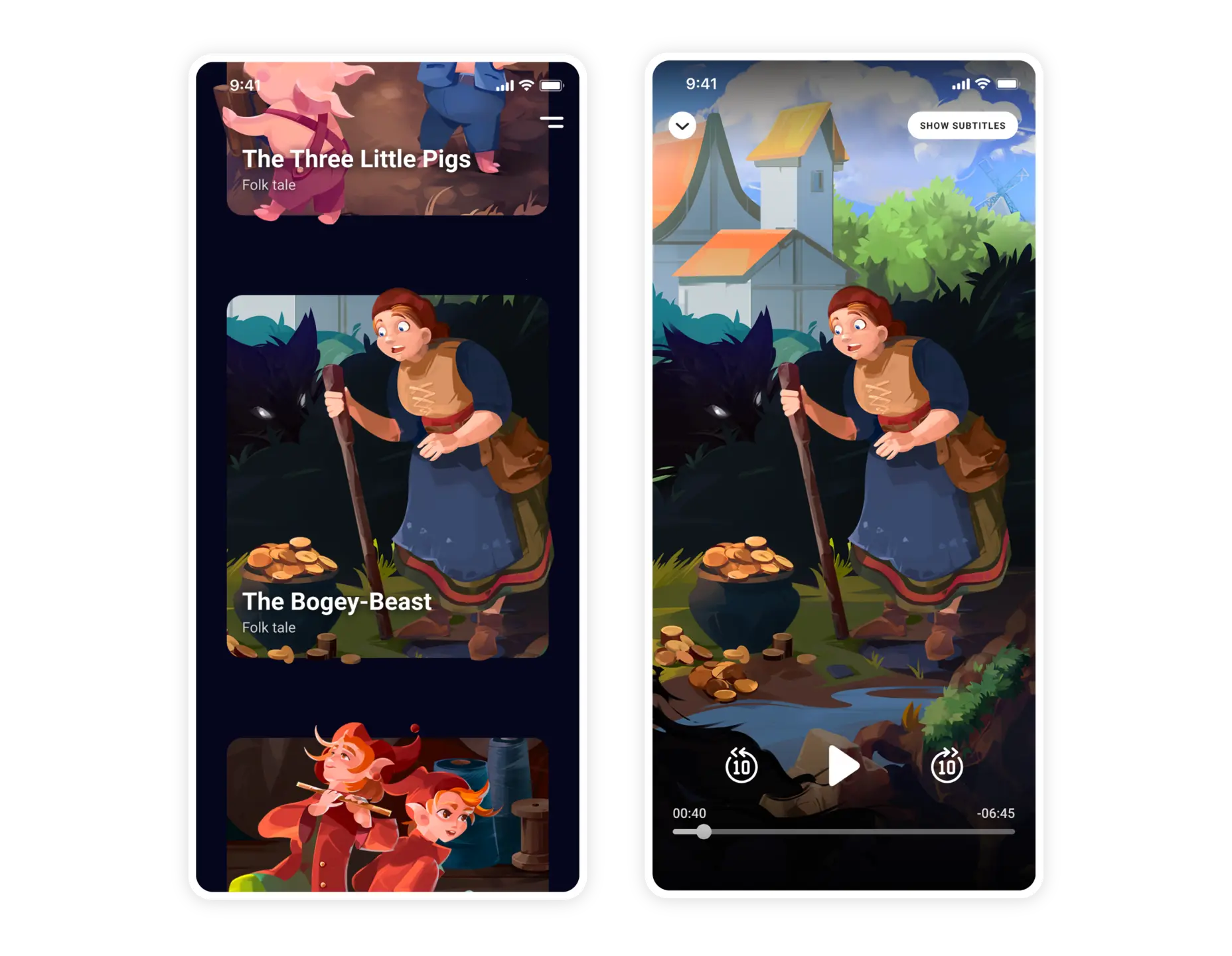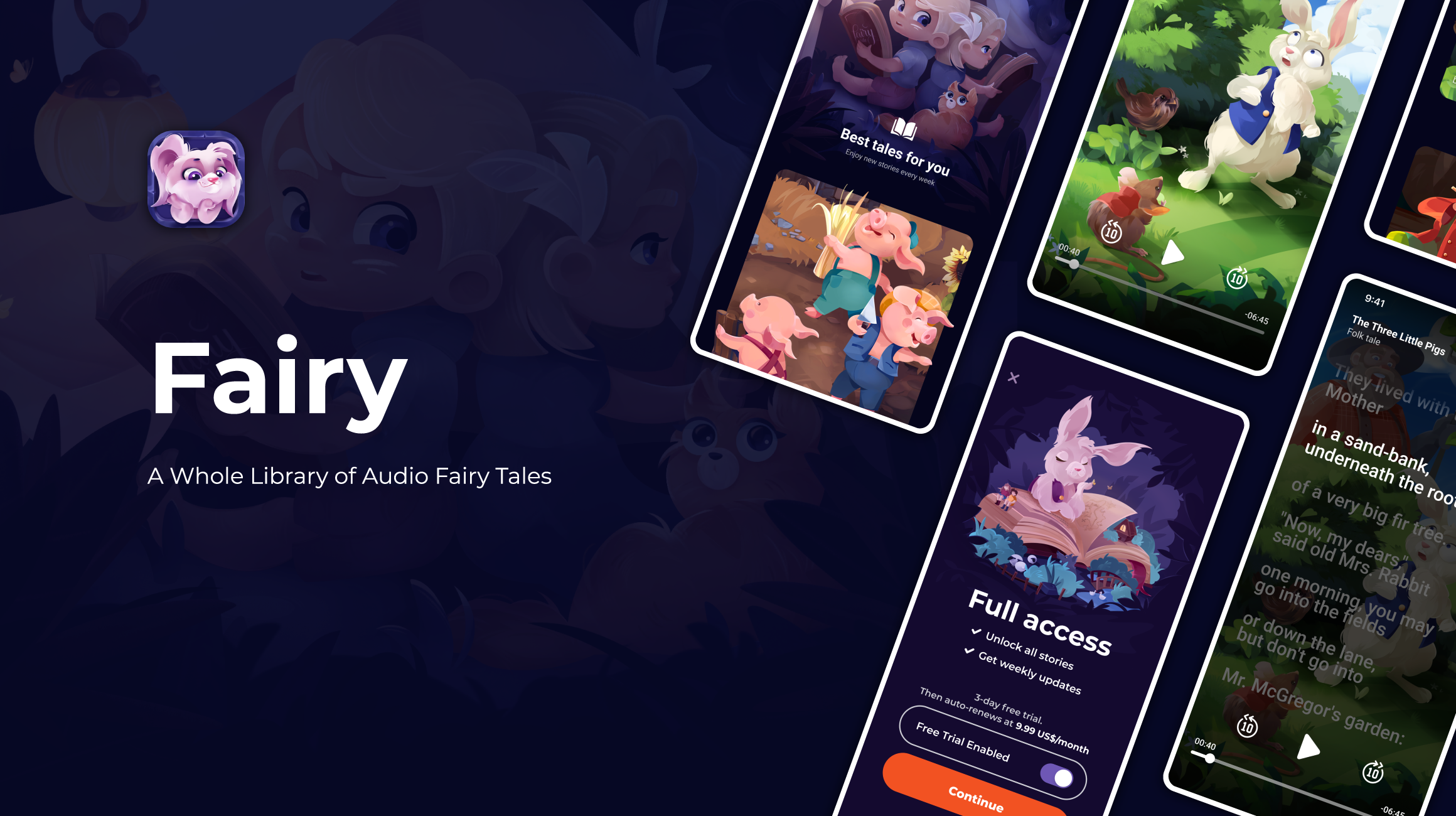- What we do
- Services
- Solutions
- Our Works
- Company
- Contact Us
October 25, 2020
Fairy – A Whole Library of Audio Fairy Tales
From the dawn of time, parents have read bedtime stories to children and there is no tradition sweeter and more pleasant. But what do you do after a long workday when you have no energy to read stories and fairy tales? Or what if you run out of time? Don’t worry, there is already a solution – Fairy!
Many of us looked forward to listening to bedtime stories during our childhood. However, nowadays a lot has changed in people's lives: Working remotely is extending their workday until late in the evening, someone has to work overtime to meet a deadline, or someone simply comes home too tired to read bedtime stories. But this does not change the fact that children are still waiting for that very bedtime story, and without it, they don’t want to fall asleep. Here is where Fairy comes in.
What is Fairy, and who is it for?
Today, anyone can easily find dozens of libraries of audiobooks, which contain works for every taste and topic. Books in audio format are convenient for many reasons, and the main one is their indisputable ease of use. After all, such books can be listened to while driving, during routine work, or at any time the listener finds convenient. We came to the conclusion that it would be great to make a similar library of audio fairy tales for children. So the idea of creating Fairy was born.
Fairy is an app with fairy tales in English that can be used for various purposes – parents can keep their children occupied, or older children can turn them on themselves and listen to what they like the most. And since all the fairytales come with subtitles, it’s also a great tool used by those who want to learn English. This method, by the way, is suitable for both children and adults.
How it works
When you open the Fairy app, you see a dashboard that displays previews of fairy tales available in the app's library. If the fairy tale is free, when you click on it, it will play. If it's included in any subscription plan, the user gets taken to the subscription screen, and after the user has subscribed, they get access to all the fairy tales available in Fairy.
You can also adjust the fairy tale both forward and backward, with the ability to fast-forward in 10-second increments. Additionally, there is a button for enabling synchronized subtitles, which can be turned on or off at will.
The large library of audio fairy tales contained within the app provides convenient usage for both the subscriptions and non-subscription users.
Key features
One of the app’s best features is its visual content, which was created from scratch by our team. Each of the fairy tales has its own eye-pleasing cover image, hinting at the main plot of a fairy tale.

Also, each fairy tale has its own subtitles that were written by our team and a unique voice-over by a native speaker. After the voice-over of the fairy tale is recorded, our team creates scripts and set time-stamps for the entire text so they are synchronized.
Team
A team of four people worked on this project, including:
- Backend developer
- IOS developer
- Android developer
- Project manager
Time frame
Since the application is quite large and requires a detailed approach, the development time was slightly longer than originally anticipated. As a result, about four months passed from the moment the concept was developed to the launch of the application.
Tech stack
Initially, we started working only with Amplitude because we needed analytics. We implemented it from the very beginning since it was necessary to immediately understand how the audience interacts with the app, what indicators the app achieves, and what to do with it in the future.
Java was used for writing the backend, and Swift – for the frontend, which is quite standard.
To work successfully with subtitles, we used the StackEdit editor – an insanely convenient editor for working with text, which has a very large number of features and allows you to work with a variety of formats.
Also, in order to be able to work with deep links, we used Branch. Deeplinking allows you to simplify the path to content for a new audience and improve the user experience for existing users.
We chose Firebase as a tool for distribution. In a nutshell, Firebase can help you tackle demanding challenges, whether you’re a developer, marketer, or product manager. Its tools work together so that mobile teams can improve app performance while gaining valuable user insights.
We have also recently been connecting to Appfigures, which collects all the necessary analytics on its own. It helps to keep track of downloads, revenue, and store performance of the app in one place so we can recognize trends and make more informed decisions.
Challenges & solutions
When working on the Fairy app, the main challenge for us was working with synchronized subtitles, since we didn't have any experience with them from any of our other projects. In this regard, we started searching for the most optimal solution and came to work with the SRT files of video subtitles in SubRip format. SubRip is a small utility that can convert subtitles from video or audio files to the simple SubRip text format.
We not only needed to understand how to do it, but also who should do it, because this format of work is a bit different from programming. As a result, most of these SRT files were written by our Android developer. This decision was more efficient and successful for us than hiring a third-party specialist would be.

How we monetize it
Sometimes, even high-quality and interesting content cannot guarantee good monetization. We also faced this challenge: Despite the high ratings of the app and a large number of positive reviews from users, the number of in-app purchases made and the conversion rate during the trial period were low.
We decided to study this issue and came to the conclusion that most of the users are converted at the onboarding stage. We decided to test the theory in practice and made an onboarding, which presents information about our application, and then gives the opportunity to subscribe. We also offered to start a trial period and implemented a special offer with various discounts for semi-annual and annual subscriptions. As a direct result, we observed an increase in conversion.
In general, monetization of the app is very simple: There is free content, and there is also paid content available by trial or subscription.
Results and plans
Now our app is in great demand: We get positive feedback and stories about how children ask their parents to turn on our fairy tales both every night before going to bed as well as just to listen to during the day. Such stories and feedback are very motivating and inspire us to expand the range of fairy tales.
In the near future, we plan to create more content, add more fairy tales to the library, and introduce short stories that only last a minute.
We are also considering the idea of introducing white noise to the Fairy app for babies who can't fall asleep in silence.
Conclusion
We adults are almost always used to denying ourselves certain pleasures for the sake of work or other pressing matters. But how do you refuse a child that asks for a fairy tale? That's why we are happy to work on such a useful and interesting project, which at the same time makes the life of adults a little easier, and the evenings of children a little more pleasant.
It’s impossible to overestimate the benefits of fairy tales, because fairy tales make this world a little kinder, which means that the Fairy app also adds a drop of good.
If you've got any questions, feel free to write to us!
Contact usGot a project in mind?
Fill in this form or send us an e-mail
Subscribe to new posts.
Get weekly updates on the newest design stories, case studies and tips right in your mailbox.
